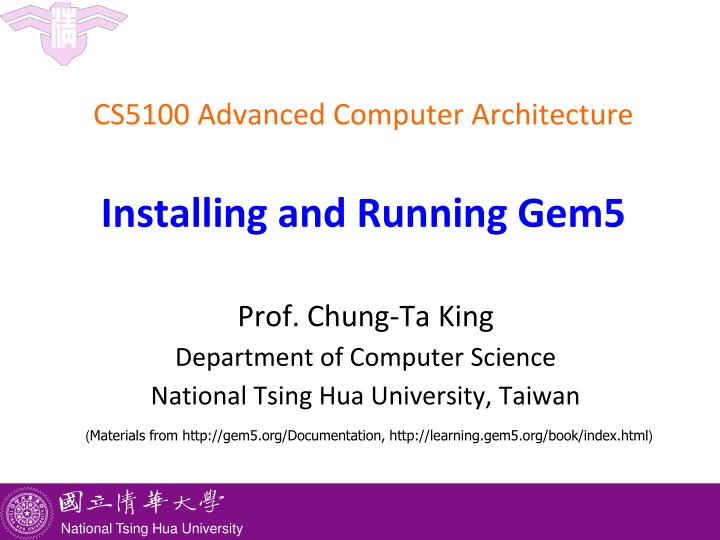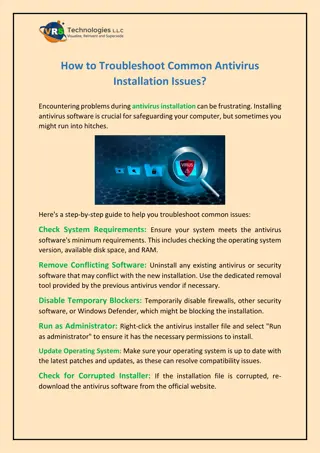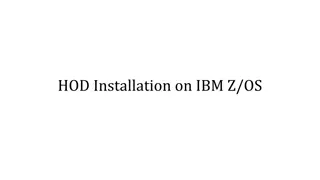
Gem5 Simulator Platform for Computer Architecture Study
Explore Gem5, a versatile modular computer system simulator platform, and learn how to install, configure, and run it for architecture study purposes at National Tsing Hua University in Taiwan.
Download Presentation

Please find below an Image/Link to download the presentation.
The content on the website is provided AS IS for your information and personal use only. It may not be sold, licensed, or shared on other websites without obtaining consent from the author. If you encounter any issues during the download, it is possible that the publisher has removed the file from their server.
You are allowed to download the files provided on this website for personal or commercial use, subject to the condition that they are used lawfully. All files are the property of their respective owners.
The content on the website is provided AS IS for your information and personal use only. It may not be sold, licensed, or shared on other websites without obtaining consent from the author.
E N D
Presentation Transcript
CS5100 Advanced Computer Architecture Installing and Running Gem5 Prof. Chung-Ta King Department of Computer Science National Tsing Hua University, Taiwan (Materials from http://gem5.org/Documentation, http://learning.gem5.org/book/index.html) National Tsing Hua University
Outline Installing Gem5 SPEC2006 for Gem5 Configuring Gem5 1 National Tsing Hua University
Gem5 Gem5 is a modular discrete event driven computer system simulator platform: Modular: Gem5's components can be rearranged, parameterized, extended or replaced easily Discrete-event driven: It simulates the passing of time as a series of discrete events Computer system simulator: Its intended use is to simulate one or more computer systems in various ways It is a simulator platform that lets you use its premade components to build up your own simulation system Supports for executing Alpha, ARM, MIPS, Power, SPARC, and 64 bit x86 binaries on CPU models, including single CPI models, out of order model, in order pipelined model 2 National Tsing Hua University
Gem5: Two Modes Full system (FS) Simulate a complete system with devices and an operating system Models bare hardware, including devices, interrupts, exceptions, privileged instructions, fault handlers Syscall emulation (SE) For running user space only programs where system services are provided directly by the simulator Models user-visible ISA plus common system calls System calls emulated, typically by calling host OS Simplified address translation model, no scheduling 3 National Tsing Hua University
Building Gem5 for Architecture Study Our goal is to build a simple simulator that allows us to study architectures of desktop computers Syscall emulation (SE) mode No need to install full systems (FS) SPEC CPU2006 benchmark suites Alpha ISA (SPEC CPU2006 only available on Alpha ISA) 4 National Tsing Hua University
Environment Setup Platform: Linux or Mac OS X If you do not have a Linux environment, the simplest way to set up one, e.g. Ubuntu, on your Windows computer is to: Install a virtualization tool, e.g. VirtualBox or VMWare, on your Windows computer Download the latest Ubuntu disk image (.iso file) and load it on a virtual disk drive, e.g. Daemon Tool, on your Windows computer Create a new virtual machine on the virtualization tool and install Ubuntu from the virtual disk drive Update your Ubuntu from a terminal: $ sudo apt-get update $ sudo apt-get upgrade If you are not familiar with Linux, there are many tutorials online to learn Now you are ready to install and run Gem5 (assuming Ubuntu) 5 National Tsing Hua University
Gem5: Quick Start Getting a copy of Gem5: Gem5's source code is managed using the Mercurial revision control system. Install Mercurial and then get a copy of the Gem5 source repository: $ sudo apt-get install mercurial $ hg clone http://repo.gem5.org/gem5 Getting additional tools to build Gem5: $ sudo apt-get install swig m4 python python-dev \ libgoogle-perftools-dev scons zlib1g-dev \ build-essential g++ (v. 4.8 or newer), SWIG (v. 2.0.4 or newer), m4, Python (v. 2.6 - 2.7), Scons (v. 0.98.1 or newer), zlib (zlib1g-dev, any recent version) 6 National Tsing Hua University
Gem5: Quick Start Building Gem5: Building gem5 with a cache protocol: $ cd gem5/ $ scons build/ALPHA_MOESI_CMP_directory/gem5.fast \ -j 6 7 National Tsing Hua University
Outline Installing Gem5 SPEC2006 for Gem5 Configuring the simulator 8 National Tsing Hua University
SPEC2006 Benchmarks Download the alpha ISA binaries of SPEC2006 GEM5_SPEC2006.tar.gz package from iLMS and move it to your gem5/ directory Or you can build it by yourself: http://www.m5sim.org/SPEC_CPU2006_benchmarks Decompress the file to get the benchmark binaries $ cd gem5/ $ tar zxvf GEM5_SPEC2006.tar.gz Different benchmarks require different input data Need to read details in each benchmark Download spec06_config.py & pec06_benchmarks.py from iLMS and move them to gem5/configs/example 9 National Tsing Hua University
Execution Script Download the script run.sh from iLMS and move it to your gem5/ directory To run using the two supportive scripts, spec06_config.py & pec06_benchmarks.py , from the previous step Can also be used to easily configure GEM5 Modify execution path within run.sh to be your own line 22: GEM5_DIR=absolute path of your gem5 directory line 23: SPEC_DIR=absolute path of benchmarks directory line 222: $GEM5_DIR/build/THE CACHE PROTOCOL YOU BUILT WITH/gem5.fast .. Usage: run.sh benchmark_name path_of_out_directory 10 National Tsing Hua University
Result You can see the result in stats.txt Note: The benchmark bzip2 needs a bigger stack. If you set up the environment according to this ppt, your have to modify the memory size. 11 National Tsing Hua University
Outline Installing Gem5 SPEC2006 for Gem5 Configuring the simulator 12 National Tsing Hua University
Configuring the Simulator gem5/cinfigs/common/Options.py contains many options to configure the simulated machine, e.g. CPU clock, memory type and size, cache size There is a help comment followed by each option to explain the meanings of the option To change the configuration of the simulated machine, you can simply add the specific option (-- option) into the launch command line at the bottom of gem5/run.sh . 13 National Tsing Hua University
Example: Change CPU Clock According to the description in Options.py , the default CPU clock is 2GHz If we want to change the CPU clock to 3GHZ, we can add --cpu-clock 3GHz at the bottom of run.sh . 14 National Tsing Hua University
Example: Enable Cache Simulation To do cache simulation, there are two things to be configured first: 1) Add "--cpu-type=timing" flag to set the CPU model that would stall on cache accesses and wait for the memory system to respond prior to proceeding. (http://www.m5sim.org/SimpleCPU#TimingSimpleCPU) 2) Add "--caches --l2cache flag to enable cache modeling. 15 National Tsing Hua University






















